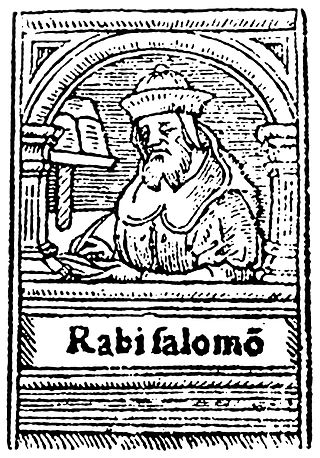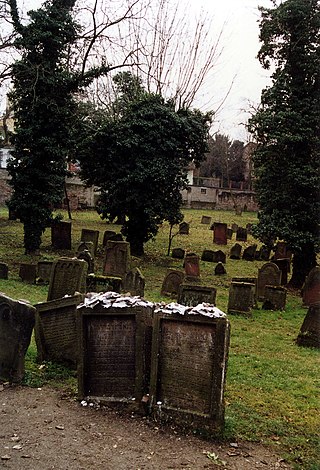Related Research Articles

Shlomo Yitzchaki, commonly known by the acronym Rashi, was a French rabbi who authored comprehensive commentaries on the Talmud and Hebrew Bible.

Rabbinic literature, in its broadest sense, is the entire spectrum of works authored by rabbis throughout Jewish history. The term typically refers to literature from the Talmudic era, as opposed to medieval and modern rabbinic writings. It aligns with the Hebrew term Sifrut Chazal, which translates to “literature [of our] sages” and generally pertains only to the sages (Chazal) from the Talmudic period. This more specific sense of "Rabbinic literature"—referring to the Talmud, Midrashim, and related writings, but hardly ever to later texts—is how the term is generally intended when used in contemporary academic writing. The terms mefareshim and parshanim almost always refer to later, post-Talmudic writers of rabbinic glosses on Biblical and Talmudic texts.

The Tosafot,Tosafos or Tosfot are medieval commentaries on the Talmud. They take the form of critical and explanatory glosses, printed, in almost all Talmud editions, on the outer margin and opposite Rashi's notes.

The Jerusalem Talmud or Palestinian Talmud, also known as the Talmud of the Land of Israel, is a collection of rabbinic notes on the second-century Jewish oral tradition known as the Mishnah. Naming this version of the Talmud after Palestine or the Land of Israel—rather than Jerusalem—is considered more accurate, as the text originated mainly from Galilee in Byzantine Palaestina Secunda rather than from Jerusalem, where no Jews lived at the time.
Menachem ben Solomon HaMeiri, commonly referred to as HaMeiri, the Meiri, or just Meiri, was a famous medieval Provençal rabbi, and Talmudist. Though most of his expansive commentary, spanning 35 tractates of the Talmud, was not publicly available until the turn of the 19th century, it has since gained widespread renown and acceptance among Talmudic scholars.
Yom Tov ben Abraham of Seville commonly known by the Hebrew acronym Ritva, was a medieval rabbi and rosh yeshiva of the Yeshiva of Seville, known for his commentaries on the Talmud.

Shlomo ben Avraham ibn Aderet was a medieval rabbi, halakhist, and Talmudist. He is widely known as the Rashba, the Hebrew acronym of his title and name: Rabbi Shlomo ben Avraham.

Meir of Rothenburg (c. 1215 – 2 May 1293) was a German Rabbi and poet, as well as a major contributing author of the tosafot on Rashi's commentary on the Talmud. He is also known as Meir ben Baruch, and by the Hebrew language acronym Maharam of Rothenburg. He was referred to by Rabbi Menachem Meiri as the "greatest Jewish leader of Zarfat " alive at the time.

SalomonBuber was a Jewish Galician scholar and editor of Hebrew works. He is especially remembered for his editions of Midrash and other medieval Jewish manuscripts, and for the pioneering research surrounding those texts.
Samson ben Abraham of Sens ,was one of the leading French Tosafists in the second half of the 12th and the beginning of the 13th centuries. He was the most outstanding student and the spiritual heir of Rabbi Isaac ben Samuel ha-Zaken. He is referred also known as "the Rash" or "the Prince of Sens", and within Tosafot as "Rashba".
Samuel ben Isaac Ha-Sardi was a Spanish rabbi who flourished in the first half of the 13th century. In his youth he attended the school of Rabbi Nathan ben Meir of Trinquetaille, Provence, and later he returned to Spain, his native country. David Conforte derives the name "Sardi" from the city of Sardinia. Zacuto calls Samuel "Ha-Sefaradi"; so does Heilprin in Seder ha-Dorot, i.216b, 292a in the Warsaw edition of 1883, but in iii.108b of the Warsaw edition of 1882 he designates him "Ha-Sardi."

Jonah ben Abraham Gerondi, also known as Jonah of Girona and Rabbeinu Yonah, was a Catalan rabbi and moralist, cousin of Nahmanides. He is most famous for his ethical work The Gates of Repentance.
Isaac ben Jacob de Lattes was a rabbi who lived in Provence. In 1372 he completed his Kiryat Sefer, including two parts, Shaarei Tzion and Toledot Yiẓḥaḳ. The first is a chronicle in which he gives valuable information concerning other Provençal authors and discusses the history of tradition, while the second is an allegorical commentary on the Torah.
Jacob ben Abraham Faitusi was a Tunisian Jewish scholar. He settled in the later part of his life at Jerusalem, whence he was sent as a collector of alms to Italy and Algeria.
Hachmei Provence refers to the hekhamim, "sages" or "rabbis," of Provence, now Occitania in France, which was a great center for Rabbinical Jewish scholarship in the times of the Tosafists. The singular form is hakham is a Sephardic and Hachmei Provençal term for a rabbi.
Judah ben Nathan, also referred to by the Hebrew acronym RiVaN, was a gifted French rabbi and commentator on the Talmud in the eleventh to twelfth century, best known for being the son-in-law and pupil of the great commentator Rashi, and to a great extent his continuator.
Rabbi Jonathan ben David ha-Kohen of Lunel was a leading French tosafist.
Solomon Sirilio (1485–1554), the son of Joseph Sirilio, was a Spanish rabbi and author of one of the first commentaries written about the Jerusalem Talmud.

Isaac ben Melchizedek, was a rabbinic scholar from Siponto, Italy, and one of the first medieval scholars to have composed a commentary on the Mishnah, of which only his commentary on Seder Zera'im survives. Elements of the Mishnaic order of Taharot are also cited in his name by the Tosafists, but the complete work is no longer extant.
References
![]() This article incorporates text from a publication now in the public domain : Louis Ginzberg (1901–1906). "Abraham of Montpellier". In Singer, Isidore; et al. (eds.). The Jewish Encyclopedia . New York: Funk & Wagnalls.Jewish Encyclopedia bibliography: De Lattes, Sha'are Zion, ed. Buber, p. 42; Neubauer, in Rev. Ét. Juives, 1884, xvii. 53; Gross, Gallia Judaica, p. 326.
This article incorporates text from a publication now in the public domain : Louis Ginzberg (1901–1906). "Abraham of Montpellier". In Singer, Isidore; et al. (eds.). The Jewish Encyclopedia . New York: Funk & Wagnalls.Jewish Encyclopedia bibliography: De Lattes, Sha'are Zion, ed. Buber, p. 42; Neubauer, in Rev. Ét. Juives, 1884, xvii. 53; Gross, Gallia Judaica, p. 326.